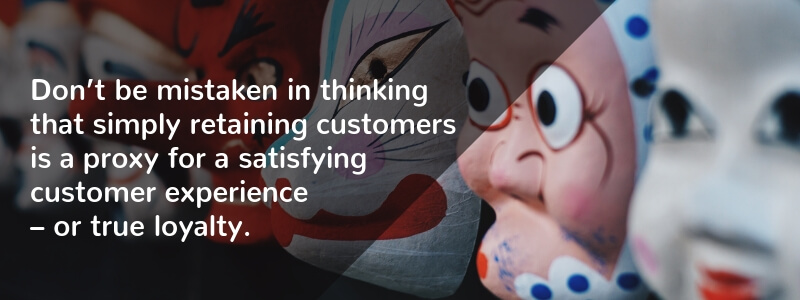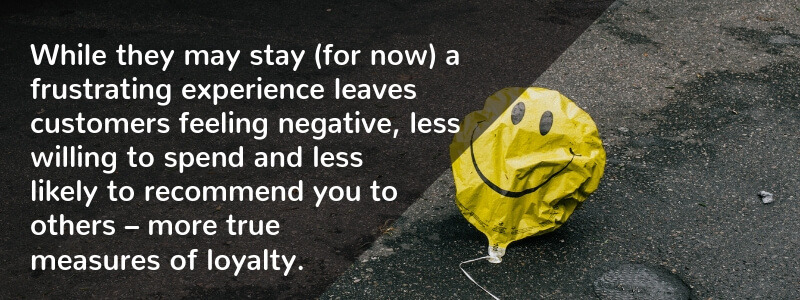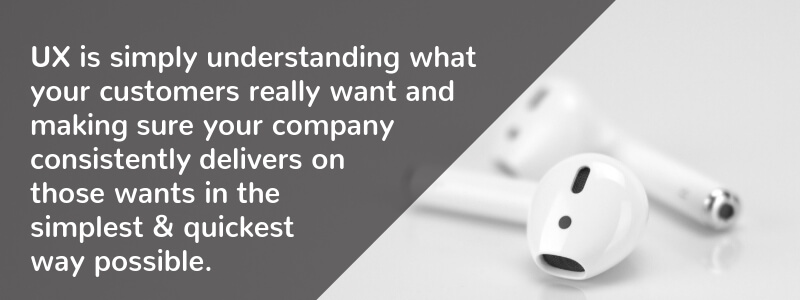Why customers stay loyal despite bad user experiences?

Why do customers stay loyal when they have had a bad service experience?
By Martin Stewart : 7th of December 2018
If you’re in insurance, you may have heard that user experience is the new battlefield. It seems obvious that in a time of increased competition every business should make it as easy as possible for customers to do business with them. And with the line between online and offline service blurring, we are urged to extend great customer experience to all interactions between a business and its customers for the lifetime of their relationship, not just at the point of sale.
However, there are plenty of companies that do NOT provide a consistently good user experience, without it seeming to lead to a significant loss of customers. With the effort that providing consistently good UX requires, are these businesses evidence that UX can be safely ignored without the risk of losing customers?
Why do some companies enjoy customer loyalty despite bad UX?

Many companies may be able to get away with confusing or tedious processes and red tape without losing a significant share of customers. But don’t be mistaken in thinking that simply retaining customers is a proxy for a satisfying customer experience – or true loyalty. Whatever is holding them there is unlikely to be a positive thing for the business, and not something that should be followed as an example.
Better the devil you know
For a significant number of customers, the reason they stay may be a matter of it being ‘better the devil you know’. A belief that the alternatives are just as bad is common in markets that have a few larger, more dominant players, such as with telecommunications or banking. Software and processes in these markets tend to be designed to make the business more cost-efficient, rather than get customers efficiently to what they want. For instance, try finding a contact phone number on the ‘contact us’ page of a major telco and you’ll see what I mean.
It seems very difficult to switch
In situations where the process to change to another provider is complex or difficult – the banks again, and internet service providers – customers may be reluctant to play a game of musical chairs in case they are left without a seat. For instance, if you have waited for 4 weeks to get an internet connection installed, you’re unlikely to switch and risk waiting another 4 weeks.
And in the banking world we all know how hard it is just to update your address with your bank. After 20 minutes on hold they may perhaps update one or two instances of your address in their records but not all. Consider then shifting fully from one bank to another. The effort is massive and, if you have credit cards, loans or mortgages, expensive.
Pure optimism
Most people are by nature optimists (a cognitive bias which explains the large number of people who continue to smoke, bungy jump or remain underinsured). Even after a bad experience, they are likely to believe that whatever problem they had is not likely to occur again. The customer eventually finds out how to get the service they need, or assumes the situation will not reoccur, and discounts the need to find a new provider.
This is particularly prevalent when the company has built a strong brand through great advertising, which makes the customer assume that the bad service must have been an exception – at least the first few times. Your brand is only what your customers believe it to be, after all.
Lack of confidence
In many cases people will assume that it is they, rather than the business who is getting it wrong. Despite possible evidence to the contrary, they will blame themselves for experiencing the problem. This is especially true for customers using online services who can think they are not smart enough to use the system or those who meet a customer service rep with a firm ‘computer says no’ philosophy that is difficult to challenge.
Inertia
They’d like to move but they are too busy right now, thank you – enough said.

So while they may be staying (for now), a frustrating experience leaves customers feeling negative, less willing to spend, and less likely to be recommending the company to others – more true measures of loyalty.
Beyond customer loyalty – other reasons why you should invest in good UX
So, given that many customers will stay loyal despite poor service, is it worth investing to improve the overall user experience? A more cynical business could say “forget worrying about a good UX, let’s just focus on making money”.
But the best companies recognise that there are numerous direct and indirect benefits to be had by investing in good UX, even beyond customer loyalty.

Financial performance – recent studies have shown that companies that lead in terms of UX also outperform their peers financially – by up to 35%.
Protection from brand damage – in the age of social media and a mobile in every hand, you never know when a single service issue is really going to blow up and damage your business. Think how much airtime the video of United Airlines staff throwing a passenger off an overbooked flight received – despite them ‘following policy’.
More motivated staff – it’s not much fun for staff to continually deal with unhappy customers and the knock-on effect is far greater than just griping in the break-out room – significant and costly impacts on productivity can occur.
Less opportunity for disrupters – disruptive newcomers love to enter markets where the more established players are known to provide bad service claiming “we’ll look after you, unlike the big guys….”. While you may be doing fine do you really want to encourage companies like Amazon or well-funded start-ups to take you on as Uber has done with the taxi industry or Spotify has done with the music industry?
Reduced servicing costs – most negative user experience is the result of weak processes or poor systems, where the cost of servicing complaints and providing manual workarounds far outweighs the cost of fixing the problem.

Finally, it should be remembered that improving UX has nothing to do with how “fancy” you can make your web page or how complex you can make service delivery. It is about understanding what services your customers really want and making sure your company consistently delivers on those wants in the simplest and quickest way possible.
For instance, simple tasks like updating your address should be possible online instead of having to ring the call centre and spending half an hour on the phone.
Harvard Business Review (HBR) says: “To really win their loyalty, forget the bells and whistles and just solve their problems. Loyalty has a lot more to do with how well companies deliver on their basic, even plain-vanilla promises than on how dazzling the service experience might be.”
